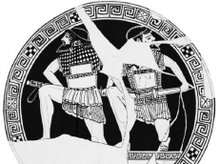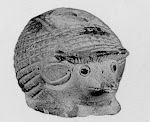Crowd forces can reach levels that almost impossible to resist or control. Virtually all crowd deaths are due to compressive asphyxia and not the "trampling" reported by the news media. Evidence of bent steel railings after several fatal crowd incidents show that forces of more than 4500 N (1,000 lbs.) occurred. Forces are due to pushing, and the domino effect of people leaning against each other.
So our common notion of "pushing" may not be adequate to completely describe what occurs. The most force may actually be transferred through coordinated "leaning" when crowd densities are very high.
Experiments to determine concentrated forces on guardrails due to leaning and pushing have shown that force of 30% to 75% of participant weight can occur. In a US National Bureau of Standards study of guardrails, three persons exerted a leaning force of 792 N (178 lbs.) and 609 N (137 lbs.) pushing. [9] In a similar Australian Building Technology Centre study, three persons in a combined leaning an pushing posture developed a force of 1370 N (306 lbs.). [10] This study showed that under a simulated "panic", 5 persons were capable of developing a force of 3430 N (766 lbs.).
Only three people exerted a force horizontally against a target by simply leaning into each other that would be the equivalent of the weight of a grown man laying on top of you. Now, you may think that you could bear this weight without suffering from asphyxia, but for how long? If the pressure from even this small group were maintained for any length of time you would succumb to exhaustion and be unable to inflate your lungs. The effect is similar to what occurs when constricting snakes, like pythons and boas, kill. The don't so much crush the breath out of you as simply make it incrementally more difficult for you to expand your diaphragm to take in air.
Another common assumption is that two opposing groups could not generate these forces against each other, that a crowd must be pushing in one direction against a wall. This next quote shows how crowd collisions can be deadly.
In the Cincinnati rock concert incident, a line of bodies was found approximately 9 m (30 ft) from a wall near the entrance. This indicates that crowd pressures probably came from both directions as rear ranks pressed forward and front ranks pushed off the wall.
I hope this demonstrates that phalanxes of 8 ranks could be deadly. Simply scaling up the leaning force from 3 people (178 lbs)to 8 people gives us 475 lbs. There is surely a loss due to lack of coordination, so this figure is probably high, but it shows the principle.
Taking just the conservative leaning estimate, 12 on 12 would be over 720lbs and 16 on 16 ranks might approach 1,000lbs.
Now how exactly to scale up these pressures I do not know, so these are simply ballpark figures. Perhaps they reflect peak pressures, or peak pressures might be much higher. Sustained pressures are smaller, but even a fraction of this force would be deadly unless the hoplites were protected by the aspis. Peak pressures could surely even crush the aspis, as we know occurred in some battles, which would then leave the hoplite defenseless against further compression.
For some further reading: http://www.crowddynamics.com/Main/Fruin%20-%20causes.htm





6 comments:
Excellent research fellow RAT'er! I just wanted to add one supplemental comment: other than the physical element, there certainly is a mental/psychological element as well. This mental aspect would be compounded by the physical othismos as well as all the other terrible things that happen during combat.
-Ioannes Ahenobarbus
This is very true, and we can add the terror of a panicked crowd to the aleady overwelming fear of combat.
I have not touched on this because many authors have.
プロフ作成記念に嬉しくなって写メも載せちゃいましたぁ。皆さん見てください。できればメールの方に感想なども欲しいなぁ!夏休みなので暇してます。natu.no.natuyasumi@docomo.ne.jp
Hmmm...Until I get this translated I don't know if it is an informative comment or a viagra advertisement. Comments in English, French, Spanish, or Italian are much appreciated because I can read them.
Intteresting thoughts
Post a Comment